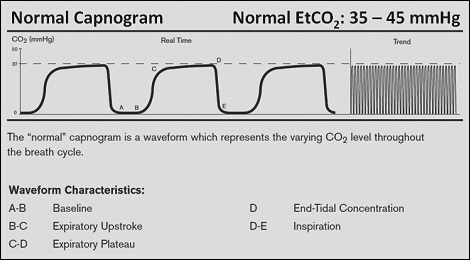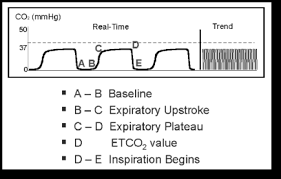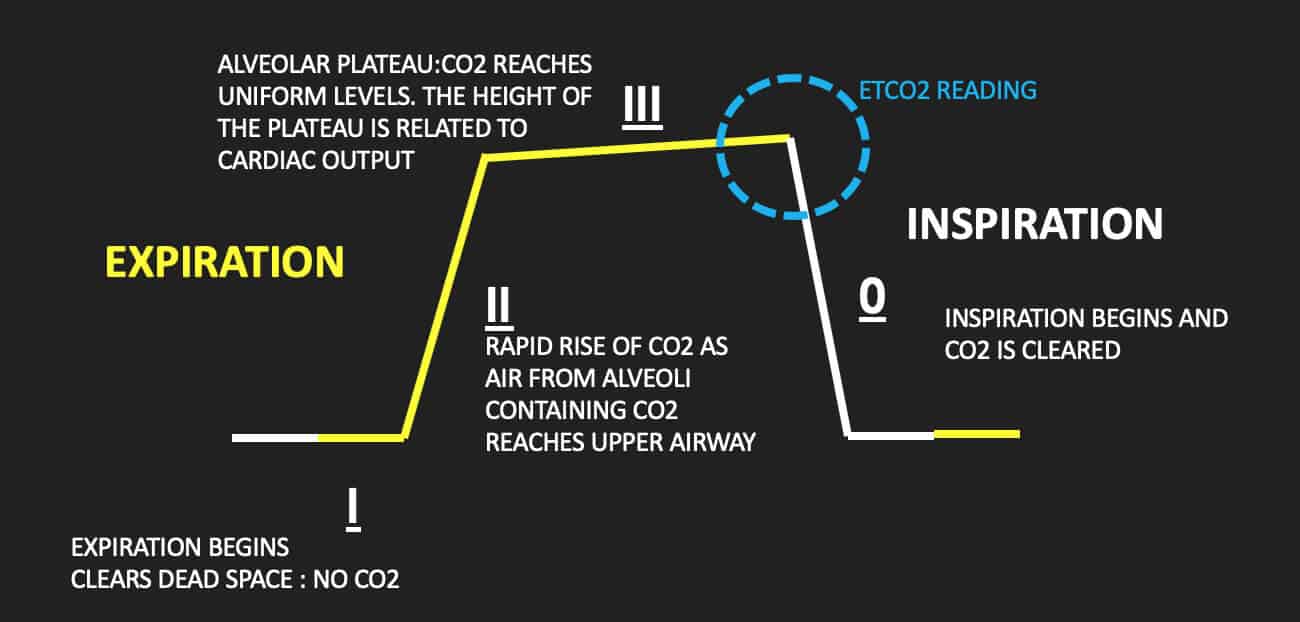end tidal co2 range
The current guidance recommends an end-to-end carbon dioxide ETCO2 concentration of 4. In the awake adult normal cardiac index lies between 25-4 Lminm2 with an ETCO2 of 35-45 mmHg.
Riding The Wave Of Capnography Understanding Etco2 Vetbloom Blog
Norm al EtCO2 levels 46 to 60 kPa signify adequate perfusion.

. NaHC03 will increase EtCO2 because it splits into CO2 and H20 So if rises after NaHCO3 do not misinterpret as ROSC Vasopressors will decrease ETCO2 they cause high afterload increasing BP and myocardial blood flow but a decrease in cardiac output. End-tidal CO2 EtCO2 monitoring is a noninvasive technique which measures the partial pressure or maximal concentration of carbon dioxide CO2 at the end of an exhaled breath which is expressed as a percentage of CO2 or mmHgThe normal values are 5 to 6 CO2 which is equivalent to 35-45 mmHg. Once that has been done you can use an end tidal Co2 monitor as opposed to drawing multiple ABGs.
The normal range of 35 to 45mmHg. Capnograph is an indispensable tool for monitoring metabolic and respiratory function. Throughout the resuscitation end-tidal CO 2 was consistently in the 28-36 mmHg range during VFCPR.
6 hours after continuous epidural infusion is discontinued c. End tidal CO 2 monitoring is represented as a number and a graph on a monitor. So the short answer is you are right about the ranges 35-45 but that is for actual PaCo2 drawn from an ABG.
Capnography can be used to assess unresponsive patients ranging from those are actively seizing to victims of chemical terrorism. Capnography waveforms etCO2 and breathing patterns. Continuous Waveform Capnograpy is written as PETCO2 which stands for patient end-tidal carbon dioxide.
End tidal co2 range high Monday April 4 2022 Edit. The presence of a normal waveform denotes a patent airway and spontaneous breathing. Monitoring of end-tidal carbon dioxide EtCO2 is a noninvasive method that measures the partial pressure or maximal concentration of carbon dioxide CO2 at the end of exhaled breath which is expressed as a percentage of CO2.
78 Nitrogen 21 Oxygen 1 CO2 and other gases Exhaled gases. Hypocapnia hypotension and hypertension during aneurysm occlusion in patients with an aneurysmal subarachnoid hemorrhage may lead to a poor prognosis but evidence for end-tidal carbon dioxide ET co 2 and mean arterial pressure MAP targets is lackingWithin the ranges of standardized treatment the authors aimed to study the association between hypocapnia Pa. Accuracy of end-tidal PCO2 measurements using a sidestream capnometer in infants and children ventilated with the Sechrist infant ventilator.
End-tidal carbon dioxide ETCO2 is the level of carbon dioxide that is released at the end of an exhaled breath. Current guidance recommends an end- tidal carbon dioxide ETCO2 of 4045 kPa 300 338 mm Hg to achieve a low- normal arterial partial pressure of CO2 PaCO2 and reduce secondary brain injury. Utility of end-tidal carbon dioxide detector during stabilization and transport of critically ill children.
Carbon dioxide is produced in the body as a by-product of metabolism and is eliminated by exhaling. In this study the aim was to review the applications of end-tidal carbon dioxide ETCO2 monitoring in emergency department multiple databases were comprehensively searched with combination of following keywords. IV narcotics discontinued d.
All reports to physicians respiratory therapy or RRT must be documented in the EMR. In normal conditions CO2 is 5 to 6 which is equivalent to 35-45 mmHg. End-tidal CO2 may be useful here as an easily and immediately measurable index of changes in cardiac output.
Capnography can be used to measure end-tidal CO 2. Waveform and end -tidal carbon dioxide EtCO2 values. ETC02 monitoring may be discontinued when.
PCA pump is discontinued b. By lowering the arterial partial pressure of CO2 PaCO2 to 8 mm Hg secondary brain injury can be reduced. Also called capnometry or capnography this noninvasive technique provides a breath-by-breath analysis and a continuous recording of ventilatory status.
21 Hillier SC Badgwell JM Mcleod ME Creighton RE Lerman J. Since problems with lungs are not common and gas exchange between alveoli and the blood is swift and effective. The power consumption is 5 kPa 30.
End Tidal CO 2 6 Can also be measured and monitored in spontaneously. What Is A Normal End Tidal Co2. End-tidal carbon dioxide ETco 2 monitoring provides valuable information about CO 2 production and clearance ventilation.
ETCO2 emergency department monitoring and critical. The waveform is called capnograph and shows how much CO 2 is present at each phase of the respiratory. An increase in etCO2 by 5 appears to have reasonable sensitivity 71-91 and specificity 94-100 for fluid responsiveness in two studies of patients breathing passively on the ventilator.
What Should End-tidal Co2 Be Kpa. It is best to get an ABG along side the end tidal to calculate the patients shunt. Since problems with lungs are not common and gas exchange between alveoli and the blood is swift and effective.
35-40 mm Hg PETCO2 less than 10 indicates ineffective chest compressions. Understanding End Tidal CO 2 Monitoring. In fact its commonly called the ventilation vital sign.
In conditions of normal breathing 6 Lmin 12 breathsmin 500 ml for tidal volume etCO 2 is very close to alveolar CO2. Measuring End Tidal CO2 Daltons Law. Patient end-tidal carbon dioxide.
MmHg Relate to the air we breath. 78 Nitrogen 21 Oxygen 1 CO2 and other gases Exhaled gases. Total pressure of a gas is the sum of the partial pressures of the gas Expired CO2 measured PetCO2 mmHg in waveform Percentage Normal Levels PaO2 85-100mmHg PaCO2 35-45mmHg Percentage vs.
As stated before end tidal is slightly different. Available evidence has established that ETCO2 measurement can provide an indication of cardiac output and pulmonary blood flow24 Non. Ensure proper rate approximately 100min Ensure proper depth with adequate releaserecoil of thorax 12 thorax or minimum 25 inches Persistently low EtCO.
Per moderate sedation monitoring policy. The normal values are 5-6 CO2 which is equivalent to 35-45 mmHg. According to the book by Hockenberry and Wilson 2015 p 1140 normal values of ETCO2 are 30-43 mmHg which is slightly lower than arterial PaCO2 35-45mmHg.
The number is called capnometry which is the partial pressure of CO 2 detected at the end of exhalation ranging between 35 - 45 mm Hg or 40 57 kPa. When CO2 diffuses out of the lungs into the exhaled air a device called a capnometer. ETCO2 levels reflect the adequacy with which carbon dioxide CO2 is carried in the blood back to the lungs and exhaled.
End-tidal capnography or end-tidal CO2 EtCO2 monitoring is a non-invasive technique that measures the partial pressure or maximal concentration of carbon dioxide CO2 at the end of an exhaled breath.

3 Waveform Capnography Showing Changes In The End Tidal Carbon Dioxide Download Scientific Diagram

Waveform Capnography In The Intubated Patient Emcrit Project

Basic Waveform Capnography As A Continuous Monitoring Tool During Mechanical Ventilation

Potential Applications Of Capnography In The Prehospital Setting Journal Of Paramedic Practice

Etco2 Capnography Monitoring Rt Comps Annual Respiratory Therapy Competency Assessment In The Workplace

Exhaled Carbon Monoxide End Tidal Co2 And Peripheral Oxygen Saturation Download Table
Emdocs Net Emergency Medicine Educationcapnography In The Ed Emdocs Net Emergency Medicine Education

Pdf Applications Of End Tidal Carbon Dioxide Etco2 Monitoring In Emergency Department A Narrative Review Semantic Scholar

The Impact Of Ventilation Rate On End Tidal Carbon Dioxide Level During Manual Cardiopulmonary Resuscitation Resuscitation

Different Capnography Traces A Sudden Drop In E 0 Co2 B Download Scientific Diagram

Exhaled Carbon Monoxide End Tidal Co2 And Peripheral Oxygen Saturation Download Table

Pdf Capnography In Pediatric Critical Care Unit And Correlation Of End Tidal And Arterial Carbon Dioxide In Ventilated Children

Capnogram R Series Defibrillator Zoll Medical Uk

End Tidal Carbon Dioxide Recording Of Ventilated Children In Picu N 535 Download Scientific Diagram

Waveform Capnography In The Intubated Patient Emcrit Project

Capnography Provides Bigger Physiological Picture To Maximize Patient Care Jems Ems Emergency Medical Services Training Paramedic Emt News

